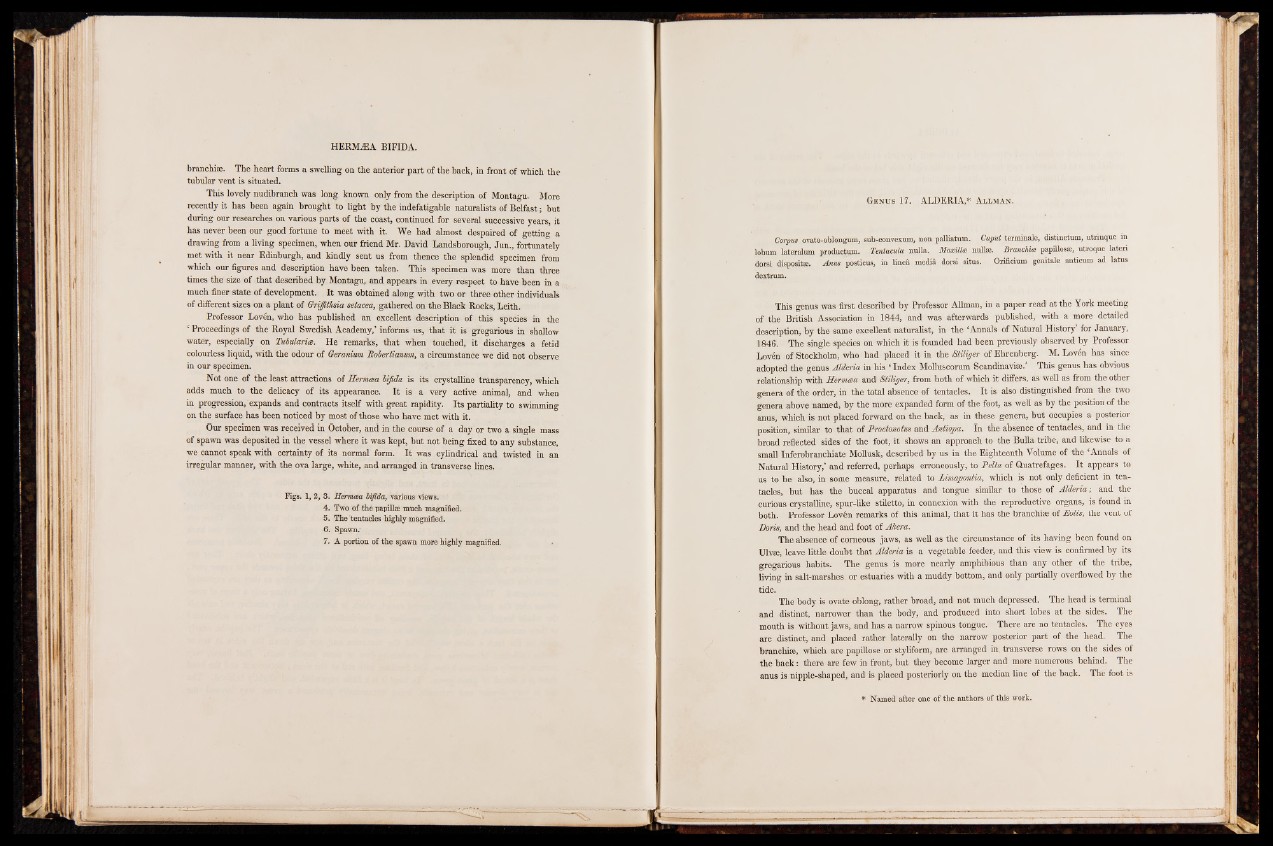
HERMÄA BIFIDA.
branchiae. The heart forms a swelling on the anterior part of the back, in front of which the
tubular vent is situated.
This lovely nudibranch was long known only from the description of Montagu. More
recently it has been again brought to light by the indefatigable naturalists of Belfast; but
during our researches on various parts of the coast, continued for several successive years, it
has never been our good fortune to meet with it. We had almost despaired of getting a
drawing from a living specimen, when our friend Mr. David Landsborough, Jun., fortunately
met with it near Edinburgh, and kindly sent us from thence the splendid specimen from
which our figures and description have been taken. This specimen was more than three
times the size of that described by Montagu, and appears in every respect to have been in a
much finer state of development. It was obtained along with two or three other individuals
of different sizes on a plant of Griffithia setacea, gathered on the Black Rocks, Leith.
Professor Loven, who has published an excellent description of this species in the
‘ Proceedings of the Royal Swedish Academy,’ informs us, that it is gregarious in shallow
water, especially on Tubularia. He remarks, that when touched, it discharges a fetid
colourless liquid, with the odour of Geranium Rolertianum, a circumstance we did not observe
in our specimen.
Not one of the least attractions of Hermcea MJida is its crystalline transparency, which
adds much to the delicacy of its appearance. It is a very active animal, and when
in progression, expands and contracts itself with great rapidity. Its partiality to swimming
on the surface has been noticed by most of those who have met with it.
Our specimen was received in October, and in the course of a day or two a single mass
of spawn was deposited in the vessel where it was kept, but not being fixed to any substance,
we cannot speak with certainty of its normal form. It was cylindrical and twisted in an
irregular manner, with the ova large, white, and arranged in transverse lines.
Figs. 1, 8, 3.
4.
5.
6.
Hermcea bifida, various views.
Two of the papillae much magnified.
The tentacles highly magnified.
Spawn:
A portion of the spawn more highly magnified.
Genus 17. ALDERIA,* Allman.
Corpus ovato-oblongum, sub-con vexum, non palliatum. Caput terminale, distinctum, utrinque in
lobum lateralum productum. Tentacule nulla, Mamllee nullæ. BranxUx papfflosæ, utroque lateri
dorsi dispositæ. Anus posticus, in lineâ mediâ dorsi situs. Orificium génitale anticum ad latus
dextrum.
This genus was first described by Professor Allman, in a paper read at the York meeting
of the British Association in 1844, and was afterwards published, with a more detailed
description, by the same excellent naturalist, in the ‘Annals of Natural History’ for January,
1846. The single species on which it is founded had been previously observed by Professor
Loven of Stockholm, who had placed it in the Stiliger of Ehrenberg. M. Loven has since
adopted the genus Alderia in his ‘ Index Molluscorum Scandinaviae.’ This genus has obvious
relationship with Hermcea and Stiliger, from both of which it differs, as well as from the other
genera of the order, in the total absence of tentacles. It is also distinguished from the two
genera above named, by the more expanded form of the foot, as well as by the position of the
anus, which is not placed forward on the back, as in these genera, but occupies a posterior
position, similar to that of JProetonotus and Antiopa. In the absence of tentacles, and in the
broad reflected sides of the foot, it shows an approach to the Bulla tribe, and likewise to a
small Inferobranchiate Mollusk, described by us in the Eighteenth Volume of the ‘Annals of
Natural History,’ and referred, perhaps erroneously, to Delta of Quatrefages. It appears to
us to be also, in some measure, related to limapontia, which is not only deficient in tentacles,
but has the buccal apparatus and tongue similar to those of Alderia; and the
curious crystalline, spur-like stiletto, in connexion with the reproductive organs, is found in
both. Professor Lov6n remarks of this animal, that it has the branchiae of Eolis, the vent of
Doris, and the head and foot of AJcera.
The absence of corneous jaws, as well as the circumstance of its having been found on
Ulvae, leave little doubt that Alderia is a vegetable feeder, and this view is confirmed by its
gregarious habits. The genus is more nearly amphibious than any other of the tribe,
living in salt-marshes or estuaries with a muddy bottom, and only partially overflowed by the
tide.
The body is ovate oblong, rather broad, and not much depressed. The head is terminal
and distinct, narrower than the body, and produced into short lobes at the sides. The
mouth is without jaws, and has a narrow spinous tongue. There are no tentacles. The eyes
are distinct, and placed rather laterally on the narrow posterior part of the head. The
branchiae, which are papillose or styliform, are arranged in. transverse rows on the sides of
the back: there are few in front, but they become larger and more numerous behind. The
anus is nipple-shaped, and is placed posteriorly on the median line of the back. The foot is
* Named after one of the authors of this work.